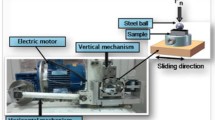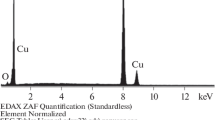Abstract
The results of studying the properties of copper galvanic coatings fabricated using an L1-210 v2 galvanic installation (Italy) using the bright copper plating electrolyte produced by 24 Karata (Moscow) and the addition of electroerosion copper nanopowder fabricated by the electroerosion dispersion (EED) method using copper wire scrap in distilled water are given. An original setup developed by the authors (RF Patent 2449859) was used for the EED of conductors. The friction coefficient and wear factor found when testing coatings using a Tribometer automated friction machine (CSM Instruments, Switzerland) indicate the absence of substantial distinctions in the wear resistance of the samples. Surface hardness tests of the sample were performed using a DM-8 automated microhardness tester according to the micro-Vickers method with an indenter load of 25 g by ten imprints with a free selection of the indentation point according to GOST (State Standard) 9450–76. The indenter loading time was 15 s. It is established that the microhardness of a copper coating with the addition of copper nanoparticles is 15% higher than that of steel substrate and the sample with a standard copper coating.
Similar content being viewed by others
References
Kolmykov, D.V, Restoration and hardening of automobile parts with galvanic coatings, Glavn. Mekhanik, 2010, no. 10, pp. 33–38.
Serebrovsky, V.V. and Safronov, R.I, Restoration and hardening of machine parts with galvanic coatings, Mekhaniz. Elektrif. Sel’sk. Khoz., 2007, no. 1, pp. 18–19.
Yudin, V.M, Restoration of parts of agricultural machinery with zinc-based galvanic coatings, Vestn. Orlovsk. Gos. Agrarn. Univ., 2009, vol. 16, no. 1, pp. 24–25.
Vinogradova, S.S., Kaidrikov, R.A., and Zhuravlev, B.L, Electrochemical methods of controlling corrosion resistance of multilayered electroplated coatings, Vestn. Kazansk. Tekhnol. Univ., 2006, no. 3, pp. 116–120.
Vinogradova, S.S., Kaidrikov, R.A., and Zhuravlev, B.L, Development of electrochemical controlling methods of corrosion resistance of multilayered electroplated coatings, Al’manakh Sovrem. Nauki Obrazovan., 2008, no. 7, pp. 39–42.
Yudin, V.M., Vikharev, M.N., and Filina, N.N, Restoration of parts with zinc-based galvanic coatings at high current densities, Tr. GOSNITI, 2012, vol. 110, no. 2, pp. 58–60.
Proskurkin, E.V. and Sukhomlin, D.A, Analysis of zinc coatings based on their structural and electrochemical properties, Korroz.: Mater., Zashch., 2013, no. 10, pp. 30–38.
Malyshev, V.V. and Gab, A.I., High-temperature galvanic coating of molybdenum, tungsten and their carbides from ionic melts, Fizikokhim. Poverkhn. Zashch. Mater., 2012, vol. 48, no. 2, pp. 213–217.
Kireev, S.Yu. and Perelygin, Yu.P., Theory, measurement methods and application field of transition resistance of galvanic coatings, Gal’vanotekhn. Obrab. Poverkhn., 2010, vol. XVIII, no. 4, pp. 19–26.
Dorofeev, Yu.G., Lipkin, M.S., Naumenko, A.A., Rybalko, E.A., Sirotin, P.V., Ivashin, I.N., and Lipkin, V.M, Obtaining copper powders from ammonia electrolytes and their properties, Izv. Vyssh. Uchebn. Zaved. Poroshk. Metall. Funkts. Pokryt., 2012, no. 3, pp. 3–7.
Zolotukhina, L.V., Kuznetsov, M.V., Gel’chinskii, B.R., Zhidovinova, S.V., and Arefyev, I.G, Surface investigation of ultrafine particles of copper powders formed by the vapor-phase condensation, Izv. Vyssh. Uchebn. Zaved. Poroshk. Metall. Funkts. Pokryt., 2011, no. 1, pp. 14–20.
Artamonov, V.V., Artamonov, V.P., Perekopnaya, E.Yu., Abishev, A.A., Suyundikov, M.M., and Bykov, P.O, Study of the cementation process of deposition of copper powder, Izv. Vyssh. Uchebn. Zaved. Poroshk. Metall. Funkts. Pokryt., 2013, no. 2, pp. 3–7.
Ageev, E.V. and Horyakova, N.M, Morphology of copper powder produced by electrospark dispersion from waste, Russ. Eng. Res., 2014, vol. 34, no. 11, pp. 694–696.
Ageev, E.V. and Horyakova, N.M, Morphology and composition of copper electrospark powder suitable for sintering, Russ. Eng. Res., 2015, vol. 35, no. 1, pp. 33–35.
Ageev, E.V., Horyakova, N.M., and Malukhov, V.S, Production of copper electroerosion nanopowders from wastes in kerosene medium, J. Nano- and Electron. Phys., 2014, vol. 3, pp. 03011-1–03011-3.
Author information
Authors and Affiliations
Corresponding author
Additional information
Original Russian Text © E.V. Ageeva, R.A. Latypov, N.M. Horyakova, E.V. Ageev, 2016, published in Izvestiya Vysshikh Uchebnykh Zavedenii, Poroshkovaya Metallurgiya i Funktsional’nye Pokrytiya, 2016, No. 1, pp. 35–43.
About this article
Cite this article
Ageeva, E.V., Latypov, R.A., Horyakova, N.M. et al. Insight into physicomechanical and tribological properties of copper galvanic coatings formed with the addition of electroerosion copper nanopowder. Russ. J. Non-ferrous Metals 58, 161–167 (2017). https://doi.org/10.3103/S106782121702002X
Received:
Revised:
Accepted:
Published:
Issue Date:
DOI: https://doi.org/10.3103/S106782121702002X




